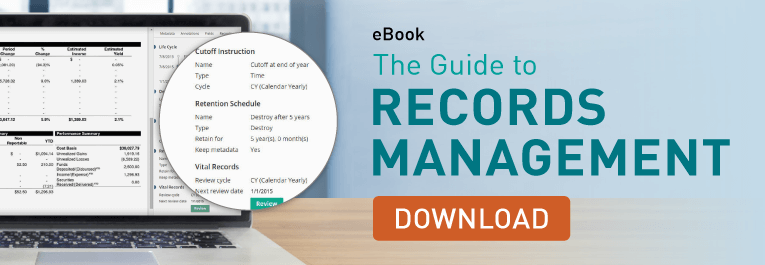DoD 8180.01, 5015.02 and DTM-22-001 – Everything You Need to Know
When it comes to finding a platform that ensures records are managed properly, it can be difficult without a standard to go by. Fortunately, The United States Department of Defense (DoD) provides such a standard. In addition, the DoD offers a wide variety of documents and tools to evaluate the effectiveness of a records management solution or strategy.
Primarily used by the DoD itself to ensure it is managing records in accordance with specific laws, these standards and tools provide a robust framework for organizations to manage records thoughtfully and effectively. By using this framework, organizations can take a step beyond the universal electronic records management (ERM) requirements outlined by The National Archives and Records Administration (NARA), that are used to support federal agencies in maintaining compliance with the Federal Records Act.
While an organization may not be required by law to follow DoD records management standards, effective records management can encourage more informed business decisions, a boon for any organization.
What is DoD 8180.01?
DoD 8180.01, or “Information Technology Planning for Electronic Records Management” is a tool for the Department of Defense to evaluate an electronic records management platform’s potential to comply with policies set out in DoD Instruction 5015.02, “DoD Records Management Program”.
Some of the key components of DoD 8180.01 include:
- A reduced focus on certification and narrow technical requirements.
- An increased focus on a solution’s ability to facilitate effective records management.
- An acknowledgment that a record’s lifecycle may outlast a particular platform’s lifespan.
What is DoD 5015.02?
DoD Instruction 5015.02, or “DoD Records Management Program” is a document that outlines the policy and responsibilities of the DoD as they relate to records management across media. This is not to be confused with DoD 5015.02-STD, which was a tool used to evaluate whether a particular piece of electronic records management software could be used by an organization to maintain compliance with the policies and responsibilities outlined in DoD Instruction 5014.02.
DoD 8180.01 effectively replaces 5015.2-STD as a tool to evaluate electronic records management software, but does not replace DoD Instruction 5015.02 itself, with that document offering compliance guidelines for managing records in a wider range of media.
What is the DoD Records Strategy?
Published openly for the first time in 2023, the DoD Records Strategy defines goals and offers administrative guidance for the DoD as they relate to records management. This document provides a framework for managing records largely organized into three distinct objectives:
- Curate: Be clear and effective in identifying records and adding the appropriate contextual information as needed.
- Automate: Leverage automation to save time and enable staff to focus more of their resources on core responsibilities.
- Govern: Keep information accessible to relevant parties to enable more strategic decision making across departments.
In addition to the above, the records strategy emphasizes more universal accountability for managing records outside of the records manager role. It also suggests having dedicated records specialists embedded in units across the organization, to work in tandem with subject matter experts that ideally would also gain some records management knowledge and capability.
What is DTM-22-001?
DTM-22-001, or “DoD Standards for Records Management Capabilities in Programs Including Information Technology” works essentially as an addendum to the DoD Instruction 5015.02, to eventually be incorporated into the instruction at a later time.
These standards, focused on software, ultimately serve to enshrine in policy the ideas brought about by the newer strategy-based, non-policy documents such as DoD 8180.01 and the DoD Records Strategy.
The new policies require that:
- A safe harbor period is established for information stored on IT systems once it is deleted.
- IT systems support the proper disposition of records.
- Records management functionality is provided for IT systems.
- Records and record control items remain interoperable between IT systems.
Bringing it all together
With all the different tools and documents that the DoD has to offer records managers, let’s quickly go over the purpose of each once more:
- DoD Instruction 5015.02: Establishes policies for the DoD to follow in order to properly manage its records.
- DoD Manual 8180.01: Offers criteria to evaluate a piece of software’s ability to assist an organization in complying with the guidelines in DoD Instruction 5015.02.
- DoD Records Strategy: Provides administrative guidance and sets up goals for the DoD to work toward as it strives to manage records as effectively as possible.
- DTM-22-001: Acts as addition to the policies outlined in 5015.02, outlining requirements for IT systems in regards to the disposition, management and transfer of records.
Using these tools together can yield a robust and effective records management framework. As discussed earlier, many organizations are not required to manage records as strictly as the DoD.
However, with the emergence of new technologies and the reality that many organizations use a variety of applications and information for everyday business, even the DoD acknowledges that records management should be thought of as a functional discipline rather than the following of rules for the sake of them.
More than anything, developing a robust and effective records management strategy can save your organization time in classifying and storing information, encourage more informed decision making and allow staff across the enterprise to dedicate more resources to their core responsibilities.
Customer Spotlight: City of Ithaca/Tompkins County
Learn how one county in New York reduced the time to furnish records in response to FOIA requests by more than half.
Browse customer reviews of Laserfiche on G2
Get insights from real customers on why Laserfiche is a top choice for organizations looking to encourage better recordkeeping.
Further reading
If you’re looking to expand your digital transformation beyond electronic records management, an enterprise content management system (ECM) may be the right fit for your organization. Learn more about the ECM market and top vendors by checking out the G2 Grid® for Enterprise Content Management (ECM):
Already considering Laserfiche as your records management solution? Take a look at the Laserfiche Solution Marketplace, a hub for pre-built workflows and templates that customers can use to jumpstart processes necessary to meet all kinds of challenges, including regulatory needs, such as building permit applications and inspections. Whether you’re just getting started with records management or looking for new insights, be sure to check out our Ultimate Guide to Records Management to see how you can improve your information governance strategy.


